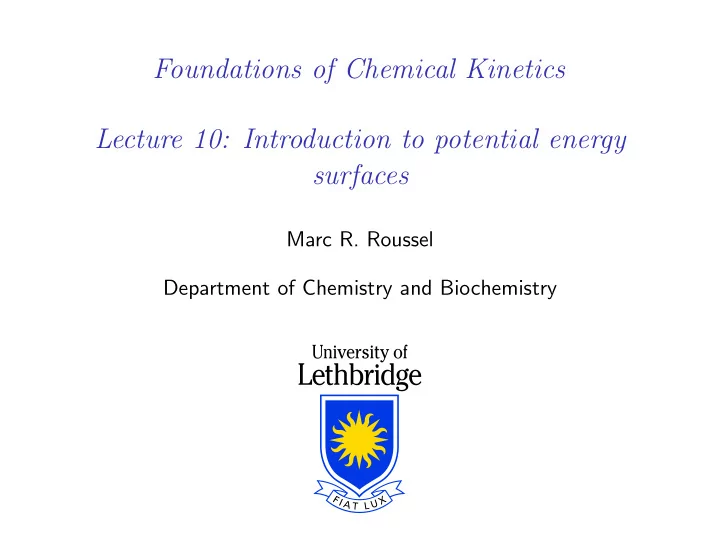

Foundations of Chemical Kinetics Lecture 10: Introduction to potential energy surfaces Marc R. Roussel Department of Chemistry and Biochemistry
Born-Oppenheimer revisited ◮ In an earlier lecture, we discussed the Born-Oppenheimer approximation which allows us to compute an effective potential (i.e. effective forces) acting on the nuclei as a function of nuclear positions. ◮ Types of interactions: Bonded strong, roughly parabolic potentials Nonbonded ⇒ intermolecular forces ◮ A variety of functional forms ◮ May depend on both the distance and relative orientations of the molecules
Examples of intermolecular forces Force V ( R ) q 1 q 2 Coulomb 4 πǫ 0 R − q 1 µ 2 cos θ Ion-dipole µ i : dipole moment 4 πǫ 0 R 2 µ 1 µ 2 Dipole-dipole 4 πǫ 0 R 3 (sin θ 1 sin θ 2 − 2 cos θ 1 cos θ 2 ) 1 α 2 (3 cos 2 θ + 1) − µ 2 Dipole-induced dipole α i : polarizability 8 πǫ 0 R 6 − 3 I 1 I 2 α 1 α 2 Dispersion I i : ionization energy 2 R 6 ( I 1 + I 2 )
Recall: effective potential for a diatomic 6 Effective potential 4 2 0 E -2 -4 -6 -8 0 1 2 3 4 5 6 7 8 R
Potential energy surfaces ◮ Consider a three-atom AB + C → A + BC reaction. ◮ The potential energy surface (PES) is a function of 3 N − 6 = 3 coordinates, which can be taken to be R AB , R BC and the A-B-C angle. ◮ This is hard to visualize. ◮ Solution: Vary (e.g.) R AB and R BC at fixed angle. ◮ Commonly, we look at a collinear collision, but other angles are possible.
A potential energy surface for a collinear reaction
A potential energy surface for ∠ ABC = π/ 4
Reaction coordinate ◮ Although somewhat artificial, we can construct a reaction coordinate that measures the progress along the lowest-energy reaction path from reactants to products. ◮ The maximum point along this path is a saddle point on the PES (downhill in either direction along the reaction coordinate, uphill in all other directions). ◮ We have 3 N − 6 internal degrees of freedom, of which one is the reaction coordinate, so there are 3 N − 7 vibrational modes. ◮ For the vibrational modes, roughly speaking, k i = ∂ 2 V /∂ q 2 i > 0, where q i is the corresponding normal-mode coordinate, and ω i ∼ √ k i . ◮ For the reaction coordinate, ∂ 2 V /∂ q 2 i < 0 so the corresponding frequency is imaginary.
Avoided crossings ◮ In diatomics, potential energy curves for electronic states with the same orbital symmetry and spin do not cross. E R ◮ In polyatomics, the potential energy curves can touch, but not cross. ◮ In the region of these avoided crossings, systems can cross from one electronic state to another. Then, a reaction can involve multiple PESs.
Recommend
More recommend